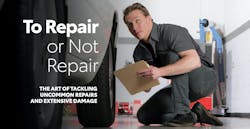Underestimating the amount of work an uncommon repair or extensively damaged vehicle will require is a mistake your shop does not want to make. To avoid this potentially costly error, it’s important that you take the time to do the research and ensure that you are writing a complete and accurate estimate.
Identifying Complex Repairs
Collision repair manuals typically contain instructions for performing light to moderate repair work on a vehicle. When instructions are missing for a part, it may be because it is an uncommon repair, or it could be an indication that the collision has breached the structure of the vehicle and extensive repairs are needed.
Some clues that could indicate you’re dealing with a vehicle that requires uncommon repairs or has been heavily damaged are:
- Damage that requires uncommon replacement parts
- Damage that has breached the vehicle’s structure
- Replacement times for the repair not included in the information provider’s guides
- Parts that do not have replacement, sectioning or repair instructions
If you see one or more of these things, you may be dealing with a complex repair that could cost more to complete than the vehicle is worth.
When approaching a complex repair, it may be tempting to cut up a large part and only replace the damaged sections. This is not recommended unless sectioning instructions are provided for the part you are replacing. If no sectioning instructions exist, the component must be installed in its entirety to the factory seam or mounting location.
Be Cautious and Have a Plan
To determine the best course of action for uncommon repairs or extensive damage to a vehicle, consider these two factors:
- Can the repair be made without compromising the safety of the vehicle?
- Can the repair be completed in a way that is cost effective for all parties involved?
A mistake that repair shops sometimes make is that they underestimate the amount of work an uncommon replacement component or major repair will require. For example, a part might only cost $300, but the labor to replace it might be $3,000! To avoid underestimating costs, take the time to perform a thorough estimate—even if it means a teardown for a complete analysis of what’s required to do the job correctly. Be cautious when writing an estimate. Conduct a complete damage assessment and develop a repair plan to ensure that you are not repairing a vehicle that should be considered a total loss.
Toyota’s Technical Information System (TIS): Your Best Resource
Your best source for the most current, extensive repair information is Toyota’s Technical Information System (TIS). The information is model-specific from 1990 through the current model year. There you’ll find collision repair manuals and Toyota Collision Repair Information Bulletins (CRIBs), which provide the most current critical updates to Toyota collision repair manuals.
Not a Toyota Technical Information System (TIS) subscriber? Contact your Toyota dealer today to enroll!
About the Author
Sponsored Content
The views and opinions expressed in this piece do not necessarily reflect those of 10 Missions Media and its associated brands.
